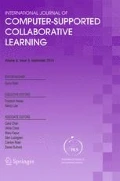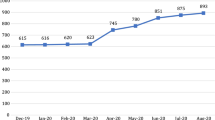Abstract
Young people’s interaction online is rapidly increasing, which enables new spaces for communication; the impact on learning, however, is not yet acknowledged in education. The aim of this exploratory case study is to scrutinize how students frame their interaction in social networking sites (SNS) in school practices and what that implies for educational language teaching and learning practices. Analytically, the study departs from a sociocultural perspective on learning, and adopts conceptual distinctions of frame analysis. The results based on ethnographic data from a Facebook group in English-learning classes, with 60 students aged between 13 and 16 from Colombia, Finland, Sweden and Taiwan indicate that there is a possibility for boundary crossing, which could generate extended spaces for collaborative language-learning activities in educational contexts where students combine their school subject of learning language and their communicative use of language in their everyday life. Such extended spaces are, however, difficult to maintain and have to be recurrently negotiated. To take advantage of young people’s various dynamic communicative uses of language in their everyday life in social media, the implementation of such media for educational purposes has to be deliberately, collaboratively and dynamically negotiated by educators and students to form a new language-learning space with its own potentials and constraints.

Similar content being viewed by others
Notes
The first 18 postings do not get any comments at all.
References
Akkerman, S. F., & Bakker, A. (2011). Boundary crossing and boundary objects. Review of Educational Research, 81(2), 132–169.
Alhabash, S., Park, H., Kononova, A., Chiang, Y. H., & Wise, K. (2012). Exploring the motivation of Facebook use in Taiwan. Cyberpsychology, Behavior, and Socialnetwork, 15(6), 304–311.
Aydin, S. (2012). A review of research on Facebook as an educational environment. Educational Technology Research and Development, 60(6), 1093–1106.
Blattner, G., & Lomicka, L. (2012). Facebook-ing and the social generation: A new era of language learning. Alsic, 15(1), http://alsic.revues.org/2413.
Bonderup Dohn, N. (2009). Web 2.0: Inherent tensions and evident challenges for education. Computer-Supported Collaborative Learning, 4(3), 343–363.
Boyd, D. (2008). Why youth (heart) social network sites: The role of networked publics in teenage social life. In I. D. Buckingham (Ed.), The John D. and Catherine T. MacArthur Foundation Series on Digital Media and Learning (pp. 119–142). Cambridge, MA: The MIT Press.
Canagarajah, S. (2006). Toward a writing pedagogy of shuttling between language: Learning from multilingual writers. College English, 68(6), 589–604.
Conole, G., & Alevizou, P. (2010). A literature review of the use of web 2.0 tools in Higher Education. York: HEA Academy.
Crook, C. (1994). Computers and the collaborative experience of learning. London: Routledge.
Crystal, D. (2011). Internet linguistics: A student guide. Oxon, UK: Routledge.
Derry, S., Pea, R. D., Barron, B., Engle, R. A., Erickson, F., Goldman, R., Hall, R., Koschmann, T., Lemke, J., Sherin, M. G., & Sherin, B. L. (2010). Conducting video research in the learning sciences: Guidance on selection, analysis, technology, and ethics. The Journal of the Learning Sciences, 19(1), 3–53.
Dirksen, V., Huizing, A., & Smit, B. (2010). “Piling on layers of understanding”: The use of connective ethnography for the study of (online) work practices. New Media & Society, 12(7), 1045–1063.
Drotner, K. (2008). Leisure is hard work: Digital practices and future competencies. In D. Buckingham (Ed.), The John D. and Catherine T. MacArthur Foundation Series on Digital Media and Learning (pp. 167–184). Cambridge, MA: The MIT Press.
Drouin, M. A. (2011). College students’ text messaging, use of textese and literacy skills. Journal of Computer Assisted Learning, 27(1), 67–75.
Ducate, L. C., & Lomicka, L. L. (2008). Adventures in the blogosphere: From blog readers to blog writers. Computer Assisted Language Learning, 21(1), 9–28.
Edwards, D., & Mercer, N. (1987). Common knowledge: The development of understanding in the classroom. London: Routledge & Keagan Paul.
Ellison, N., Steinfield, C., & Lampe, C. (2007). The benefits of Facebook “friends”: Social capital and college students’ use of online social network sites. Journal of Computer-Mediated Communication, 12(4), 1143–1168.
Farmer, B., Yue, A., & Brooks, C. (2008). Using blogging for higher order learning in large cohort university teaching: A case study. Australasian Journal of Educational Technology, 24(2), 123–136.
Goffman, E. (1959/1990). The presentation of self in everyday life. New York, NY: Anchor Books.
Goffman, E. (1974/1986). Frame analysis: An essay on the organization of experience. Boston, MA: Northeastern University Press.
Goodwin, C., & Heritage, J. (1990). Conversation analysis. Annual Review of Anthropology, 19, 283–307.
Gutiérrez, K., Rymes, B., & Larson, J. (1995). Script, counterscript, and underlife in the classroom: James Brown versus Brown v. Board of education. Harvard Educational Review, 65(3), 445–471.
Gutiérrez, K., Baquedano-López, P., & Tejeda, C. (1999). Rethinking diversity: Hybridity and hybrid language practices in the third space. Mind, Culture and Activity, 6(4), 286–303.
Hall, J. K., Cheng, A., & Carlson, M. (2006). Reconceptualizing multicompetence as a theory of language knowledge. Applied Linguistics, 27(2), 220–40.
Halliday, M. A. K. (1994/2004). An introduction to functional grammar. London: Edward Arnold.
Hemmi, A., Bayne, S., & Land, R. (2009). The appropriation and repurposing of social technologies in higher education. Journal of Computer Assisted Learning, 25(1), 19–30.
Jenkins, J. (2006). Current perspectives on teaching world Englishes as a lingua franca. TESOL Quarterly, 40(1), 157–181.
Jordan, B., & Henderson, A. (1995). Interaction analysis: Foundations and practice. The Journal of the Learning Sciences, 4(1), 39–103.
Kern, R. G., Ware, P., & Warschauer, M. (2004). Crossing frontiers: New directions in online pedagogy and research. Annual Review of Applied Linguistics, 24, 243–260.
Kramsch, C., A’Ness, F., & Lam, W. S. E. (2000). Authenticity and authorship in the computer-mediated acquisition of L2 literacy. Language, Learning and Technology, 4(2), 78–104.
Lam, W. S. E. (2000). L2 Literacy and the design of the self: A case study of a teenager writing on the internet. TESOL Quarterly, 34(3), 457–482.
Lampe, C., Wohn, D., Vitak, J., Ellison, N., & Wash, R. (2011). Student use of Facebook for organizing collaborative classroom activities. Computer-Supported Collaborative Learning, 6(3), 329–347.
Lemert, C., & Branaman, A. (Eds.). (2005). The Goffman reader. Oxford, UK: Blackwell.
Leppänen, S., Pitkänen-Huhta, A., Piirainen-Marsh, A., Nikula, T., & Peuronen, S. (2009). Young people’s translocal new media uses: A multiperspective analysis of language choice and heteroglossia. Journal of Computer-Mediated Communication, 14(4), 1080–1107.
Lewis, S., Pea, R., & Rosen, J. (2010). Beyond participation to co-creation of meaning: Mobile social media in generative learning communities. Social Science Information, 49(3), 1–19.
Ludvigsen, S. R., Lund, A., Rasmussen, I., Säljö, R. (Eds.) (2010). Introduction. Learning across sites. New tools, infrastructures and practices. London, UK: Routledge.
McBride, K. (2009). Social-networking sites in foreign language classes: Opportunities for re-creation. I. L. Lomicka, & G. Lord (Eds.), The next generation: Social networking and online collaboration in foreign language learning. CALICO Monograph Series Volume 8. San Marcos, Texas: CALICO.
Norton, B., & Toohey, K. (2011). Identity, language learning, and social change. Language Teaching, 44(4), 412–446.
Roblyer, M. D., McDaniel, M., Webb, M., Herman, J., & Witty, J. V. (2010). Findings on Facebook in higher education: A comparison of college faculty and student uses and perceptions of social networking sites. Internet and Higher Education, 13(3), 134–140.
Rogers, R. (2009). The end of the virtual: Digital methods. Amsterdam: Vossiuspers UvA.
Rosenberg, J., & Egbert, N. (2011). Online impression management: Personality traits and concerns for secondary goals as predictors of self-presentation tactics on Facebook. Journal of Computer-Mediated Communication, 17(1), 1–18.
Sacks, H., Schegloff, E. A., & Jefferson, G. (1974). A simplest systematics for the organisation of turn-taking for conversation. Language, 50(4), 696–735.
Schneider, E. W. (2011). English around the world. An introduction. Cambridge, UK: CUP.
Seedhouse, P. (2004). The interactional architecture of the language classroom: A conversation analysis perspective. Malden, MA: Blackwell.
Seidlhofer, B. (2011). Understanding English as a lingua franca. Oxford, UK: OUP.
Sfard, A. (1998). On two metaphors of learning and the dangers of choosing just one. Educational Researcher, 27(2), 4–13.
Stahl, G., Koschmann, T., & Suthers, D. (2006). Computer-supported collaborative learning: An historical perspective. In R. K. Sawyer (Ed.), Cambridge handbook of the learning sciences (pp. 409–426). Cambridge, UK: Cambridge University Press.
Thorne, S. L. (2003). Artifacts and cultures-of-use in intercultural communication. Language, Learning and Technology, 7(2), 38–67.
Thorne, S. L. (2009). ‘Community’, semiotic flows, and mediated contribution to activity. Language Teaching, 42(1), 81–94.
Turkle, S. (1995). Life on the screen: Identity in the age of the Internet. New York, NY: Simon & Schuster.
Vygotsky, L. S. (1939/1978). Mind in society: The development of higher psychological processes. Cambridge, MA: Harvard University Press.
Warschauer, M., Black, R. W., & Chou, Y.-L. (2010). Online Englishes. In A. Kirpatrick (Ed.), The Routledge handbook of world Englishes (pp. s 490–505). New York: Routledge.
Wenger, E. (2000). Communities of practice and social learning systems. Organization, 7(1), 225–246.
Wertsch, J. V. (1998). Mind as action. New York, NY: Oxford University Press.
West, A., Lewis, J., & Currie, P. (2009). Students’ Facebook ‘friends’: Public and private spheres. Journal of Youth Studies, 12(6), 615–627.
White, J. (2013). Language economy in computer-mediated communication: Learner autonomy in a community of practice. In B. Zou, M. Xing, Y. Wang, M. Sun, & C. H. Xiang (Eds.), Computer-assisted foreign language teaching and learning: Technological advances (pp. 75–90). Hershey: USA: IGI Global.
Yang, Y.-F. (2011). Learner interpretations of shared space in multilateral English blogging. Language, Learning and Technology, 15(1), 122–146.
Acknowledgments
The research reported here was funded by Marcus and Amelia Foundation and conducted within the University of Gothenburg Learning and Media Technology Studio (LETStudio), and the Linnaeus Centre for Research on Learning, Interaction and Mediated Communication in Contemporary Society (LinCS). We wish to convey our thanks to the anonymous reviewers and Gerry Stahl for their invaluable comments on a former version of this article.
Author information
Authors and Affiliations
Corresponding author
Rights and permissions
About this article
Cite this article
Lantz-Andersson, A., Vigmo, S. & Bowen, R. Crossing boundaries in Facebook: Students’ framing of language learning activities as extended spaces. Computer Supported Learning 8, 293–312 (2013). https://doi.org/10.1007/s11412-013-9177-0
Received:
Accepted:
Published:
Issue Date:
DOI: https://doi.org/10.1007/s11412-013-9177-0




